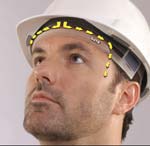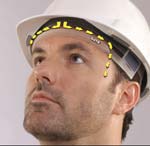
The Risks and Costs of Blurred Vision
- By Greg Thurmond
- Mar 01, 2010
 Sweat management as it relates to vision is an important and often overlooked component of heat stress. As temperatures rise, so does the amount of sweat that will drip into a worker's eyes and glasses. Blurred vision or stinging eyes can turn from annoying to dangerous in one blink of an eye. As with other safety equipment, the costs and risks associated with using inadequate protection can be great.
Sweat management as it relates to vision is an important and often overlooked component of heat stress. As temperatures rise, so does the amount of sweat that will drip into a worker's eyes and glasses. Blurred vision or stinging eyes can turn from annoying to dangerous in one blink of an eye. As with other safety equipment, the costs and risks associated with using inadequate protection can be great.
There are many considerations when selecting the best sweat management solution for your environment. Generally speaking, they fall into three main categories: function, safety and cost. As with most safety products, new cost-saving alternatives are available that address many of the age-old concerns. It is important to evaluate the benefits and costs associated with the solution you choose and to have enough information to make an informed decision. Some of the most commonly used products are absorbent cellulose sponges, cotton bandannas, and skull caps made from technical fabrics. Workers who wear hard hats may use an absorbent, terry cloth “topper” that attaches to the suspension system. New products exist that work by channeling sweat away from the eyes and glasses (similar to a rain gutter) rather than absorbing it.
Traditional products are designed to absorb sweat and therefore are prone to saturation, allowing sweat to drip into the eyes and glasses. Sweatbands that work by channeling sweat are not prone to saturation because they are made from a soft, non-absorbent plastic, so they may be worn repeatedly and typically require replacement only annually. Plastic is easy to clean and sterilize by using bleach or other common cleaners. Technical fabrics may require the use of specialized cleaners in order to adequately remove oil, dirt, and odor. Without special care, technical fabrics may not work as well to wick sweat.
Sweatbands and Heat Stress
Scientists who study sweat production have reported that athletes typically produce one to three liters of sweat per hour. In some instances, they have recorded amounts as high as six liters per hour. It is easy to argue that workers can create similar sweat production, given the hot environments and the amount of clothing and personal protective equipment (PPE) they wear. With sweat volumes like these, it is very clear why hydration is so important and why absorbent sweatbands are ineffective.
Are you confident that the products you buy do not increase heat stress? We conducted third-party thermal imaging tests with various sweatband products and proved what you may already know: Heat is released from the top of the head, so it is advantageous to allow for good circulation. When you cover the top of the head or forehead, the result is as much as a 5 percent increase in surface area temperature. In order to reduce heat stress, we concluded it is optimal to use sweatband products that cover as little surface area as possible. Because the plastic sweatbands had the lowest profile in the test group (1 centimeter tall), they simply trapped the least amount of heat and allowed for excellent air circulation.
Safety Considerations
Clear vision is a must in order for your workers to be safe. Sweat dripping down the face and into the eyes is not only annoying, it is also downright dangerous.
Stinging eyes and blurred vision can lead to a loss of focus and mistakes, thus increasing the risk of injury. Work stoppages can occur frequently as workers stop to clear their eyes, wipe their faces, or clean their safety glasses.
Very oft en, workers wear PPE, such as gloves, safety glasses, a face mask, or other protective clothing that can inhibit them from safely wiping away their sweat. For example, someone might use his gloves to wipe his face or glasses and inadvertently introduce dust, debris, or a chemical from the gloves into his eyes. To this point, health and safety managers have stated that a significant percentage of eye injuries result from workers introducing debris into their eyes while wiping sweat.
If a contaminated glove, shirt, or rag is used to clean safety glasses, they are more likely to become scratched, resulting in more frequent replacement.
Workers may choose to remove their gloves or safety glasses and even remove their hard hats to wipe sweat from their eyes. In doing so, they may violate PPE compliance standards and expose their hands, eyes, and head to a risk of injury. To follow safety procedures, they may have to move to a safe zone before they can remove their PPE and clear the sweat from their eyes.
If the work environment calls for plastic suits, air packs, or an air hose, it may complicate the challenge further, extending the time needed to complete the sweat wiping task. In some environments, such as those involving radiation, this effort may require a safety team or other personnel to assist the worker.
What should sweat management cost? Companies spend a small fortune each year on absorbent cloth and cellulose sweatbands. Although plastic sweatbands a more expensive per unit, they are a better value. Disposable and replaceable, absorbent sweatbands can easily cost $50 annually per employee compared to approximately $10 per employee for plastic, sweat-channeling sweatbands.
With disposable products ranging from 30 cents to 80 cents, frequent replacement can easily reach five figures for many companies on an annual basis. When you factor in the additional costs of injuries, work stoppages, and replacing safety glasses, the total cost to your company can be enormous.
Heat stress will continue to be a hot topic, and sweat management is an important component of it. We have a responsibility to reevaluate the total performance and cost of traditional sweatband products and compare them to new options. If you can improve worker safety by off ering a more effective solution and save money by doing so, why not start now?
This article originally appeared in the March 2010 issue of Occupational Health & Safety.